Lithium-Bearing Pegmatite Identification, Based on Spectral Analysis and Machine Learning: A Case Study of the Dahongliutan Area, NW China
Abstract
1. Introduction
2. Materials and Methods
2.1. Sample Collection and Spectral Measurement
2.2. Spectral Data Processing Method
2.2.1. Pre-Processing Techniques
2.2.2. Extraction Method for Spectral Feature Analysis
- (1)
- Spectral absorption band position P. The band interval of interest was determined, followed by a search for the minimum value of the continuum removal data in the interval.
- (2)
- Depth H: H = 1 − DH. This reflects the content of the altered minerals.
- (3)
- Full width at half-maximum (FWHM) corresponding to depth. H1 = H/2 corresponds to the wavelength value at the left and right absorption shoulders of λe, λs, W = λe − λs, as shown in Figure 4b.
- (4)
- Area A: A = Aleft + Aright.
- (5)
- Asymmetry, S: the area of the left part (Aleft) and right part (Aright).
2.2.3. Characteristic Wavelength Selection Method
2.2.4. Data Augmentation Strategy
2.2.5. Machine Learning Model Recognition Method
2.2.6. Result Verification Method
3. Results and Discussion
3.1. Extraction and Analysis of the Absorption Characteristic Parameters, Based on Local Spectrum Diagnosis
3.1.1. Spectral Feature Interval Selection
3.1.2. Spectral Characteristic Parameter Analysis
3.2. Spectral Selection Based on Full Spectral Reflectance Characteristics
3.2.1. Selection of the Best Spectral Resolution
3.2.2. Automatic Selection of Spectral Features
3.3. Establishment and Verification of the Identification Model
4. Conclusions
- (1)
- The absorption waveform characteristic parameters of the local spectral diagnosis of the Li-rich pegmatite and Li-poor pegmatite at Dahongliutan were mainly located at 1408–1413 nm, 1895–1939 nm, 2195–2210 nm, 2335–2375 nm, and 2432–2489 nm, with five intervals according to the analysis of spectral curve waveform parameters, compared with Li-poor pegmatite. Mostly, the FWHM value of Li-rich pegmatite was smaller; the absorption depth was larger around 1911 nm. The absorption position around 2200 nm has a 10 nm drift toward the short-wave direction; the symmetry is greater than 0 around 2350 nm, the FWHM is larger, and the symmetry is higher around 2445 nm.
- (2)
- Using spectrum diagnosis waveform parameter quantitative values as variables, the local parameter identification effect was good, and the AUC value was 0.843, as calculated by the ROC curve. For the full spectral reflectance characteristics recognition model, the spectrum was resampled to 35 nm; then, using the genetic algorithm to select the first-order derivative data feature subset to enhance it, the data recognition model has the best effect. The highest AUC value was 0.977.
- (3)
- The Gini coefficient of the random forest model was taken as the key variable evaluation index to compare the importance of identification predictors in the model. Some of the waveform parameters were used for mapping on GF-5 and were then combined with the first-order derivative data of the important classification band position used for mapping the spatial distribution of Li-rich pegmatite and other related lithology in three different mines. The results show that the identification effect is better in those areas with large outcrops in the Aksayi and 509 mine; the kappa coefficients are 0.907 and 0.910, respectively.
Author Contributions
Funding
Data Availability Statement
Conflicts of Interest
References
- Gourcerol, B.; Gloaguen, E.; Melleton, J.; Tuduri, J.; Galiegue, X. Re-assessing the European lithium resource potential—A review of hard-rock resources and metallogeny. Ore Geol. Rev. 2019, 109, 494–519. [Google Scholar] [CrossRef]
- Linnen, R.L.; Samson, I.M.; Jones, A.E.W.; Chakhmouradian, A. Geochemistry of the Rare-Earth Element, Nb, Ta, Hf, and Zr Deposits. In Treatise on Geochemistry, 2nd ed.; Elsevier: Amsterdam, The Netherlands, 2014; pp. 543–568. [Google Scholar]
- Linnen, R.L.; Lichtervelde, M.V.; Cerny, P. Granitic pegmatites as sources of strategic metals. Elements 2012, 8, 275–280. [Google Scholar] [CrossRef]
- Wang, H.; Gao, H.; Zhang, X.Y.; Yan, Q.H.; Xu, Y.; Zhou, K.; Dong, R.; Li, P. Geology and geochronology of the super-large Bailongshan Li–Rb–(Be) rare-metal pegmatite deposit, West Kunlun orogenic belt, NW China. Lithos 2020, 360–361, 105449. [Google Scholar] [CrossRef]
- Yin, R.; Huang, X.; Xu, Y.; Wang, C.; Wang, H.; Yuan, C.; Ma, Q.; Sun, X.; Chen, L. Mineralogical constraints on the magmatic–hydrothermal evolution of rare-elements deposits in the Bailongshan granitic pegmatites, Xinjiang, NW China. Lithos 2020, 352–353, 105208. [Google Scholar] [CrossRef]
- Gao, Y.; Bagas, L.; Li, K.; Jin, M.; Liu, Y.; Teng, J. Newly Discovered Triassic Lithium Deposits in the Dahongliutan Area, NorthWest China: A Case Study for the Detection of Lithium-Bearing Pegmatite Deposits in Rugged Terrains Using Remote-Sensing Data and Images. Front. Earth Sci. 2020, 8, 591966. [Google Scholar] [CrossRef]
- Galliski, M.A.; Perino, E.; Gasquez, J.; Zavalia, M.; Olsina, R. K-feldspar and white mica trace-element contents as a eeochemical guide for pegmatite exploration in the Panwean Pegmatitic Province. Rev. Asoc. Geológico Argent. 1997, 52, 24–32. [Google Scholar]
- Acosta, I.C.C.; Khodadadzadeh, M.; Delgado, R.T.; Gloaguen, R. Drill-core hyperspectral and geochemical data integration in a superpixel-based machine learning framework. IEEE J. Sel. Top. Appl. Earth Observ. Remote Sens. 2020, 13, 4214–4228. [Google Scholar] [CrossRef]
- Booysenab, R.; Lorenza, S.; Thiele, S.T.; Fuchsloch, W.C.; Marais, T.; Nex, P.A.M.; Gloaguen, R. Accurate hyperspectral imaging of mineralised outcrops: An example from lithium-bearing pegmatites at Uis, Namibia—ScienceDirect. Remote Sens. Environ. 2021, 269, 112790. [Google Scholar] [CrossRef]
- Liu, L.; Feng, J.; Rivard, B.; Xu, X.; Zhou, J.; Han, L.; Yang, J.; Ren, G. Mapping alteration using imagery from the Tiangong-1 hyperspectral spaceborne system: Example for the Jintanzi gold province, China. Int. J. Appl. Earth Obs. Geoinf. 2018, 64, 275–286. [Google Scholar] [CrossRef]
- Okada, N.; Maekawa, Y.; Owada, N.; Haga, K.; Kawamura, Y. Automated Identification of Mineral Types and Grain Size Using Hyperspectral Imaging and Deep Learning for Mineral Processing. Minerals 2020, 10, 809. [Google Scholar] [CrossRef]
- Schulz, B.; Merker, G.; Gutzmer, J. Automated SEM Mineral Liberation Analysis (MLA) with Generically Labelled EDX Spectra in the Mineral Processing of Rare Earth Element Ores. Minerals 2019, 9, 527. [Google Scholar] [CrossRef]
- King, T.V.V.; Clark, R.N. Spectral Characteristics of Serpentines and Chlorites Using High Resolution Reflectance Spectroscopy. Meteoritics 1986, 21, 412. [Google Scholar] [CrossRef]
- Zhang, X.; Li, P. Lithological mapping from hyperspectral data by improved use of spectral angle mapper. Int. J. Appl. Earth Obs. Geoinf. 2014, 31, 95–109. [Google Scholar] [CrossRef]
- Hunt Graham, R. Near-infrared (1.3–2.4 mu m) spectra of alteration minerals; potential for use in remote sensing. Geophysics 1979, 44, 1974. [Google Scholar] [CrossRef]
- Hunt, G.R. Spectral signature of particular minerals, in the visible and infrared. Geophysics 1977, 42, 501–513. [Google Scholar] [CrossRef]
- Clark, R.N.; Swayze, G.A.; Livo, K.E.; Kokaly, R.F.; Sutley, S.J.; Dalton, J.B.; McDougal, R.R.; Gent, C.A. Imaging spectroscopy: Earth and planetary remote sensing with the USGS Tetracorder and expert systems. J. Geophys. Res. Planets 2003, 108, 5131. [Google Scholar] [CrossRef]
- Meerdink, S.K.; Hook, S.J.; Roberts, D.A.; Abbott, E.A. The ECOSTRESS spectral library version 1.0. Remote Sens. Environ. 2019, 230, 111196. [Google Scholar] [CrossRef]
- van der Meer, F.D. Near-infrared laboratory spectroscopy of mineral chemistry: A review. Int. J. Appl. Earth Obs. Geoinf. 2018, 65, 71–78. [Google Scholar] [CrossRef]
- Wang, Z. Tectonic evolution of the western Kunlun orogenic belt, western China. J. Asian Earth Sci. 2004, 24, 153–161. [Google Scholar] [CrossRef]
- Harraden, C.L.; Mcnulty, B.A.; Gregory, M.J.; Lang, J.R. Shortwave Infrared Spectral Analysis of Hydrothermal Alteration Associated with the Pebble Porphyry Copper-Gold-Molybdenum Deposit, Iliamna, Alaska. Econ. Geol. 2013, 108, 483–494. [Google Scholar] [CrossRef]
- Hecker, C.; van Ruitenbeek, F.J.A.; Bakker, W.H.; Fagbohun, B.J.; Riley, D.; van der Werff, H.M.A.; van der Meer, F.D. Mapping the wavelength position of mineral features in hyperspectral thermal infrared data. Int. J. Appl. Earth Obs. Geoinf. 2019, 79, 133–140. [Google Scholar] [CrossRef]
- Xie, B.; Mao, W.; Peng, B.; Zhou, S.; Wu, L. Thermal-Infrared Spectral Feature Analysis and Spectral Identification of Monzonite Using Feature-Oriented Principal Component Analysis. Minerals 2022, 12, 508. [Google Scholar] [CrossRef]
- van der Meer, F.D. Analysis of spectral absorption features in hyperspectral imagery. Int. J. Appl. Earth Obs. Geoinf. 2004, 5, 55–68. [Google Scholar] [CrossRef]
- Chen, C.; Jiang, F.; Yang, C.; Rho, S.; Shen, W.; Liu, S.; Liu, Z. Hyperspectral classification based on spectral–spatial convolutional neural networks. Eng. Appl. Artif. Intell. 2018, 68, 165–171. [Google Scholar] [CrossRef]
- David, L. Reading Pegmatites: Part 3—What Lithium Minerals Say. Rocks Miner. 2017, 92, 144–157. [Google Scholar] [CrossRef]
- van der Meer, F.D.; van der Werff, H.M.A.; van Ruitenbeek, F.J.A.; Hecker, C.A.; Bakker, W.H.; Noomen, M.F.; van der Meijde, M.; Carranza, E.J.M.; Smeth, J.B.d. and Woldai, T. Multi- and hyperspectral geologic remote sensing: A review. Int. J. Appl. Earth Obs. Geoinf. 2012, 14, 112–128. [Google Scholar] [CrossRef]
- Zhang, H.; Gao, Q.; Guo, D. Thermal Infrared Reflectance Spectral Characteristics of Granitic Pegmatite Type Lithium Ore and Quantitative Inversion of Lithium Element. Mineral. Petrol. 2021, 41, 25–31. [Google Scholar] [CrossRef]
- Hui, G.; Gao, Q.; Song, L. Thermal Infrared Spectra Characteristics of Rare Metal Minerals and Rock in the Keketuohai Deposit, Xinjiang. Rock Miner. Anal. 2021, 40, 134–144. [Google Scholar] [CrossRef]
- Abdelkader, M.A.; Watanabe, Y.; Shebl, A.; El-Dokouny, H.A.; Dawoud, M. and Csámer, Á. Effective delineation of rare metal-bearing granites from remote sensing data using machine learning methods: A case study from the Umm Naggat Area, Central Eastern Desert, Egypt. Ore Geol. Rev. 2022, 150, 105184. [Google Scholar] [CrossRef]
- Cardoso-Fernandes, J.; Teodoro, A.C.; Lima, A. Remote sensing data in lithium (Li) exploration: A new approach for the detection of Li-bearing pegmatites. Int. J. Appl. Earth Obs. Geoinf. 2019, 76, 10–25. [Google Scholar] [CrossRef]
- Mashkoor, R.; Ahmadi, H.; Rahmani, A.B.; Pekkan, E. Detecting Li-bearing pegmatites using geospatial technology: The case of SW Konar Province, Eastern Afghanistan. Geocarto Int. 2022, 37, 1–22. [Google Scholar] [CrossRef]
- Morsli, Y.; Zerhouni, Y.; Maimouni, S.; Alikouss, S.; Kadir, H.; Baroudi, Z. Pegmatite mapping using spectroradiometry and ASTER data (Zenaga, Central Anti-Atlas, Morocco). J. Afr. Earth Sci. 2021, 177, 104153. [Google Scholar] [CrossRef]
- Wang, Z.; Zuo, R.; Dong, Y. Mapping of Himalaya Leucogranites Based on ASTER and Sentinel-2A Datasets Using a Hybrid Method of Metric Learning and Random Forest. IEEE J. Sel. Top. Appl. Earth Observ. Remote Sens. 2020, 13, 1925–1936. [Google Scholar] [CrossRef]
- Zhang, A.; Wang, R.; Li, Y.; Hu, H.; Lu, X.; Ji, J.; Zhang, H. Tourmalines from the Koktokay No. 3 pegmatite, Altai, NW China: Spectroscopic characterization and relationships with the pegmatite evolution. Eur. J. Mineral. 2008, 20, 143–154. [Google Scholar] [CrossRef]
- Dai, J.; Wang, D.; Dai, H. Reflectance Spectral Characteristics of Rocks and Minerals in Jiajika Lithium Deposits in West Sichuan. Rock Miner. Anal. 2018, 37, 507–517. [Google Scholar] [CrossRef]
- Cardoso-Fernandes, J.; Silva, J.; Perrotta, M.M.; Lima, A.; Teodoro, A.C.; Ribeiro, M.A.; Dias, F.; Barrès, O.; Cauzid, J.; Roda-Robles, E. Interpretation of the Reflectance Spectra of Lithium (Li) Minerals and Pegmatites: A Case Study for Mineralogical and Lithological Identification in the Fregeneda-Almendra Area. Remote Sens. 2021, 13, 3688. [Google Scholar] [CrossRef]
- Cardoso-Fernandes, J.; Teodoro, A.C.; Lima, A.; Roda-Robles, E. Semi-Automatization of Support Vector Machines to Map Lithium (Li) Bearing Pegmatites. Remote Sens. 2020, 12, 2319. [Google Scholar] [CrossRef]
- Tu, Q.; Han, Q.; Li, P.; Wang, D.; Li, J. Basic characteristics and exploration progress of the spodumene ore deposit in the Dahongliutan area, West Kunlun. Acta Geol. Sin. 2019, 93, 2862–2873. [Google Scholar]
- Tang, J.; Ke, Q.; Xu, X.; Kang, k.; Li, H.; Tan, K.; Dong, L.; Liu, Y. Magma evolution and mineralization of Longmenshan lithium-beryllium pegmatite in Dahongliutan area. West Kunlun. Acta Petrol. Sin. 2022, 38, 655–675. [Google Scholar] [CrossRef]
- Schmidt, K.S.; Skidmore, A.K. Smoothing vegetation spectra with wavelets. Int. J. Remote Sens. 2004, 25, 1167–1184. [Google Scholar] [CrossRef]
- Clark, R.N.; Roush, T.L. Reflectance spectroscopy: Quantitative analysis techniques for remote sensing applications. J. Geophys. Res. Solid Earth 1984, 89, 6329–6340. [Google Scholar] [CrossRef]
- Therien, C. Welcome to the PySptools Documentation. Available online: https://pysptools.sourceforge.io/ (accessed on 11 November 2022).
- Rinnan, Å.; van den Berg, F.; Engelsen, S.B. Review of the most common pre-processing techniques for near-infrared spectra. Trends Anal. Chem. 2009, 28, 1201–1222. [Google Scholar] [CrossRef]
- Efron, B.; Hastie, T.; Johnstone, I.; Tibshirani, R. Least angle regression. Ann. Stat. 2004, 32, 407–499. [Google Scholar] [CrossRef]
- Wang, J.; Cui, L.; Gao, W.; Shi, T.; Yin, G. Prediction of low heavy metal concentrations in agricultural soils using visible and near-infrared reflectance spectroscopy. Geoderma 2014, 216, 1–9. [Google Scholar] [CrossRef]
- Qin, K.; Ge, F.; Zhao, Y.; Zhu, L.; Li, M.; Zhou, X. Hapke Data Augmentation for Deep Learning-Based Hyperspectral Data Analysis With Limited Samples. IEEE Geosci. Remote Sens. Lett. 2020, 18, 886–890. [Google Scholar] [CrossRef]
- Charifi, R.; Es-sbai, N.; Zennayi, Y.; Hosni, T.; Bourzeix, F.; Mansouri, A. Sedimentary phosphate classification based on spectral analysis and machine learning. Comput. Geosci. 2021, 150, 104696. [Google Scholar] [CrossRef]
- Breiman, L.; Breiman, L.; Cutler, R.A. Random Forests Machine Learning. J. Clin. Microbiol. 2001, 2, 199–228. [Google Scholar] [CrossRef]
- Fawcett, T. An introduction to ROC analysis Tom. Pattern Recognit. Lett. 2006, 27, 861–874. [Google Scholar] [CrossRef]
- Yang, K.; Huntington, J.F.; Gemmell, J.B.; Scott, K.M. Variations in composition and abundance of white mica in the hydrothermal alteration system at Hellyer, Tasmania, as revealed by infrared reflectance spectroscopy. J. Geochem. Explor. 2011, 108, 143–156. [Google Scholar] [CrossRef]
- Scott, K.M.; Yang, K. Spectral Reflectance Studies of White Micas; Australian Mineral Industries Research Association Ltd.: Parkville, Australia, 1997; Volume 439, p. 35. [Google Scholar]
- Post, J.L.; Noble, P.N. The near-infrared combination band frequencies of dioctahedral smectites, micas, and illites. Clays Clay Miner. 1993, 41, 639–644. [Google Scholar] [CrossRef]
- Duke and Edward, F. Near infrared spectra of muscovite, Tschermak substitution, and metamorphic reaction progress: Implications for remote sensing. Geology 1994, 22, 621–624. [Google Scholar] [CrossRef]
- Laukamp, C.; Rodger, A.; LeGras, M.; Lampinen, H.; Lau, I.C.; Pejcic, B.; Stromberg, J.; Francis, N.; Ramanaidou, E. Mineral Physicochemistry Underlying Feature-Based Extraction of Mineral Abundance and Composition from Shortwave, Mid and Thermal Infrared Reflectance Spectra. Minerals 2021, 11, 347. [Google Scholar] [CrossRef]
- Foster, M.D. Interpretation of the Composition of Lithium Micas; United States Geological Survey Professional Paper; United States Government Printing Office: Washington, DC, USA, 1960; pp. 115–147.
- Yang, K.; Lian, C.; Huntington, J.F.; Peng, Q.; Wang, Q. Infrared spectral reflectance characterization of the hydrothermal alteration at the Tuwu Cu–Au deposit, Xinjiang, China. Miner. Depos. 2005, 40, 324–336. [Google Scholar] [CrossRef]
- Clark, R.N. Spectroscopy of rocks and minerals, and principles of spectroscopy. Remote Sens. Earth Sci. Man. Remote Sens. 1999, 3, 3–58. [Google Scholar]
- Han, J.; Chu, G.; Chen, H.; Hollings, P.; Sun, S.; Chen, M. Hydrothermal alteration and short wavelength infrared (SWIR) characteristics of the Tongshankou porphyry-skarn Cu-Mo deposit, Yangtze craton, Eastern China. Ore Geol. Rev. 2018, 101, 143–164. [Google Scholar] [CrossRef]
- Mariotto, I.; Thenkabail, P.S.; Huete, A.; Slonecker, E.T.; Platonov, A. Hyperspectral versus multispectral crop-productivity modeling and type discrimination for the HyspIRI mission. Remote Sens. Environ. 2013, 139, 291–305. [Google Scholar] [CrossRef]
- Li, H.D.; Liang, Y.Z.; Long, X.X.; Yun, Y.H.; Xu, Q.S. The continuity of sample complexity and its relationship to multivariate calibration: A general perspective on first-order calibration of spectral data in analytical chemistry. Chemom. Intell. Lab. Syst. 2013, 122, 23–30. [Google Scholar] [CrossRef]
- Laakso, K.; Peter, J.M.; Rivard, B.; White, H.P. Short-Wave Infrared Spectral and Geochemical Characteristics of Hydrothermal Alteration at the Archean Izok Lake Zn-Cu-Pb-Ag Volcanogenic Massive Sulfide Deposit, Nunavut, Canada: Application in Exploration Target Vectoring. Econ. Geol. 2016, 111, 1223–1239. [Google Scholar] [CrossRef]
- Hunt, G.R.; Ashley, R.P. Spectra of altered rocks in the visible and near infrared. Econ. Geol. 1979, 74, 1613–1629. [Google Scholar] [CrossRef]
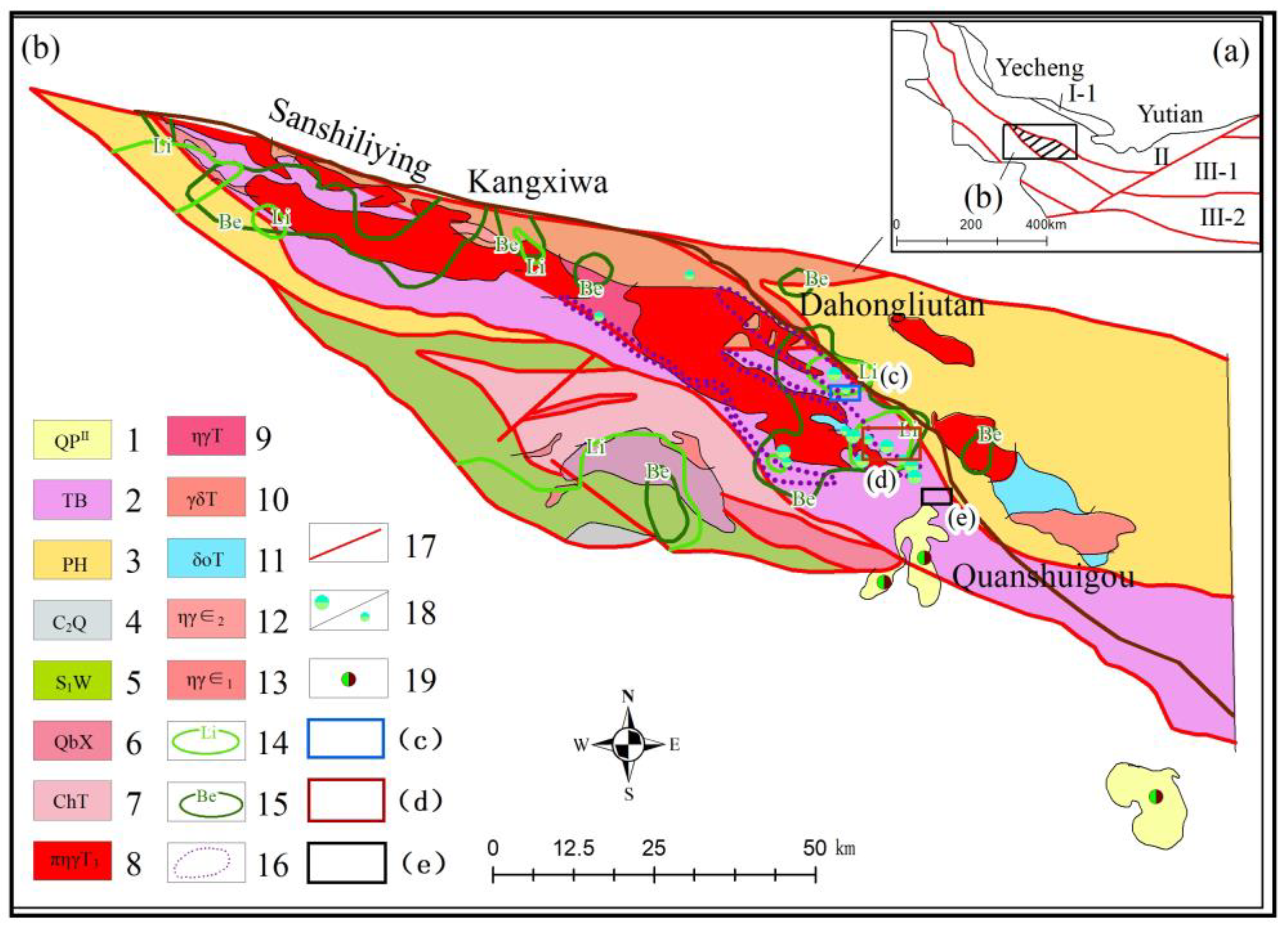

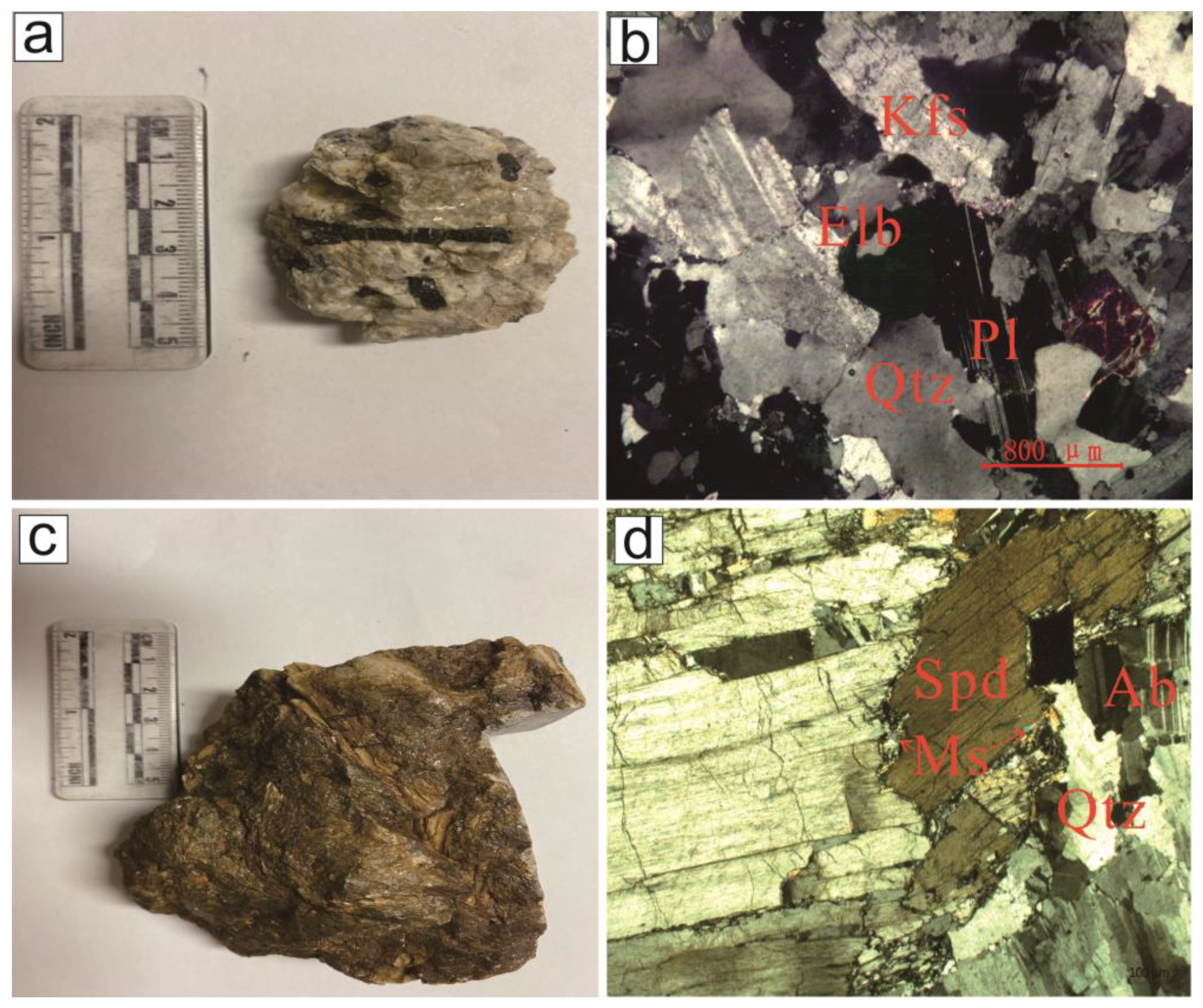
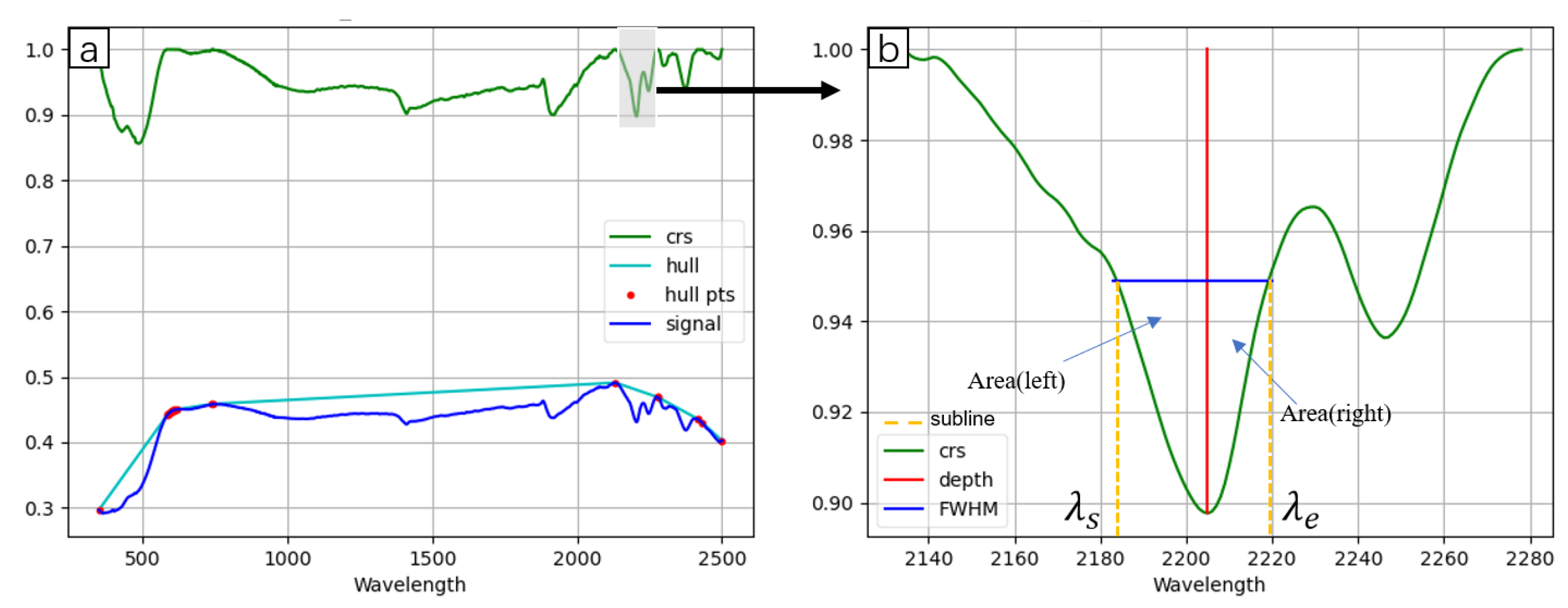
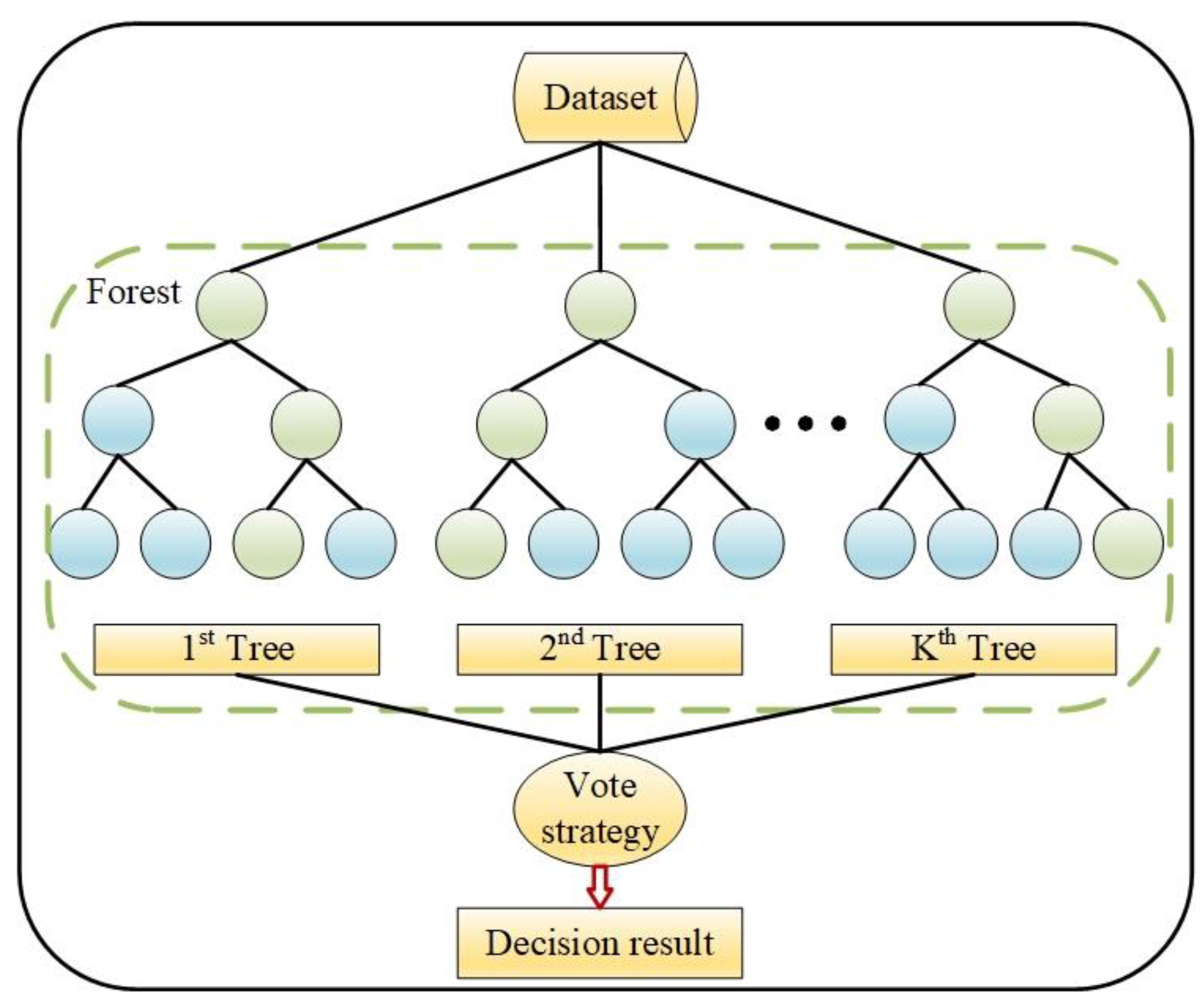
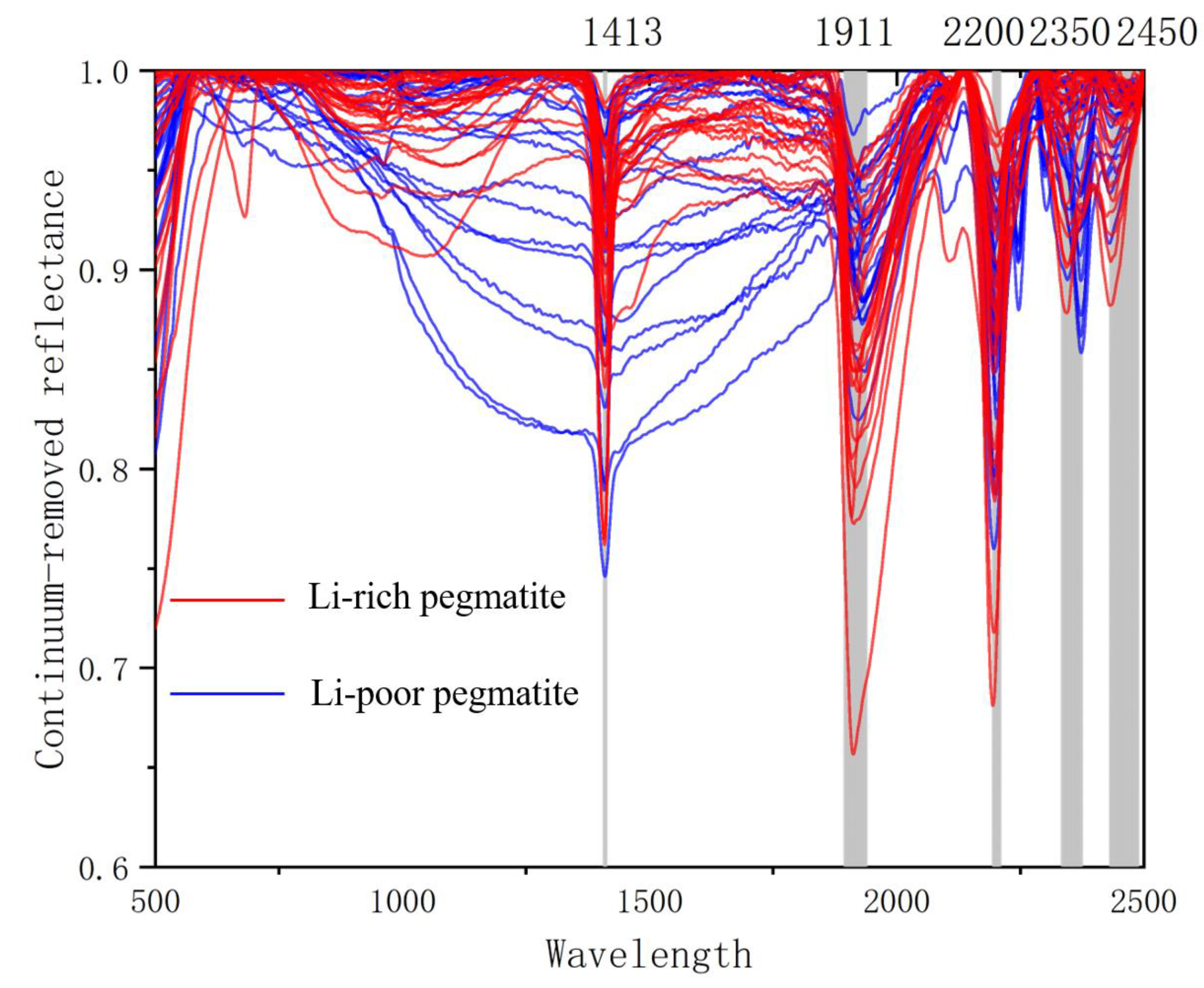
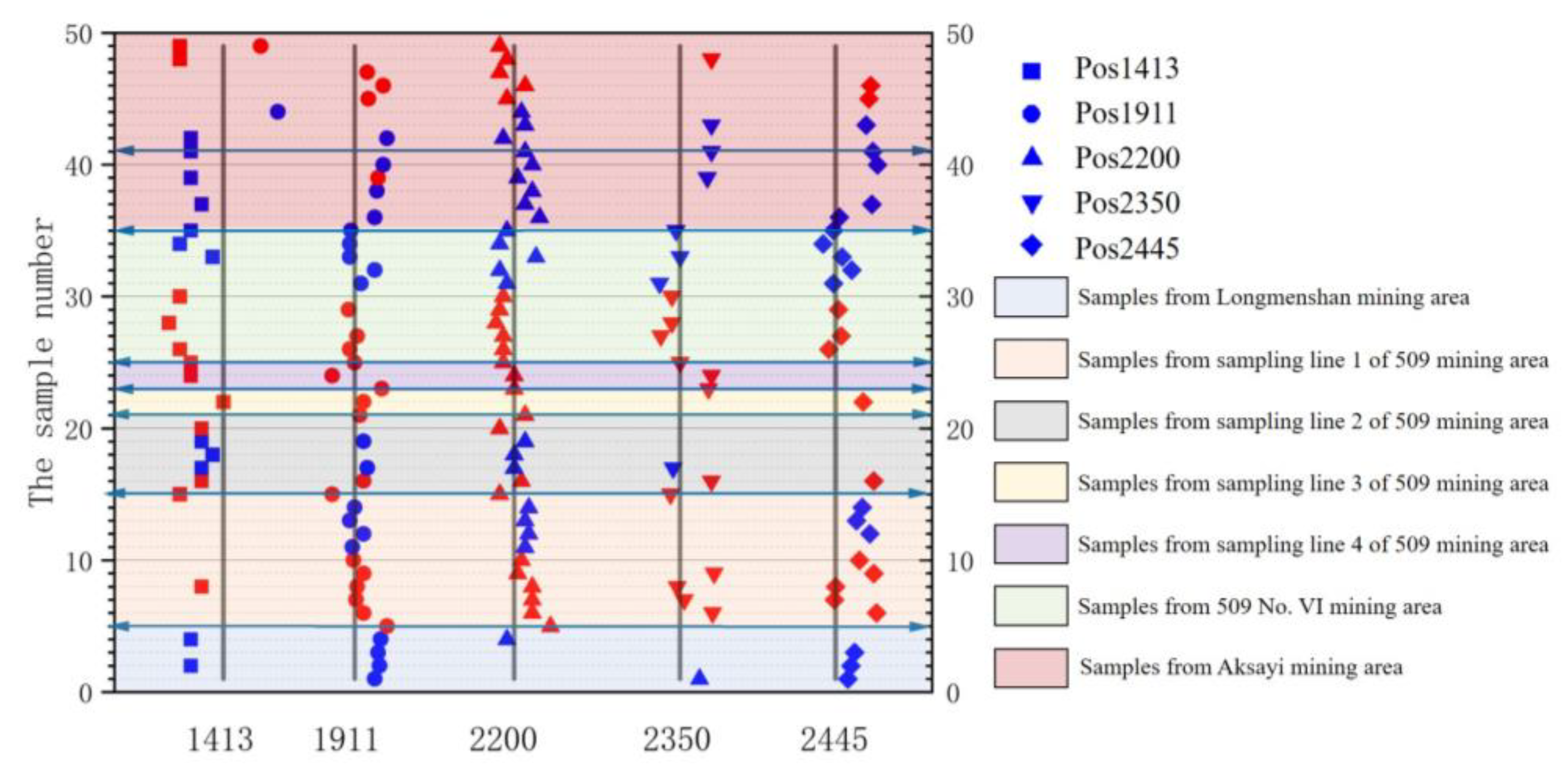
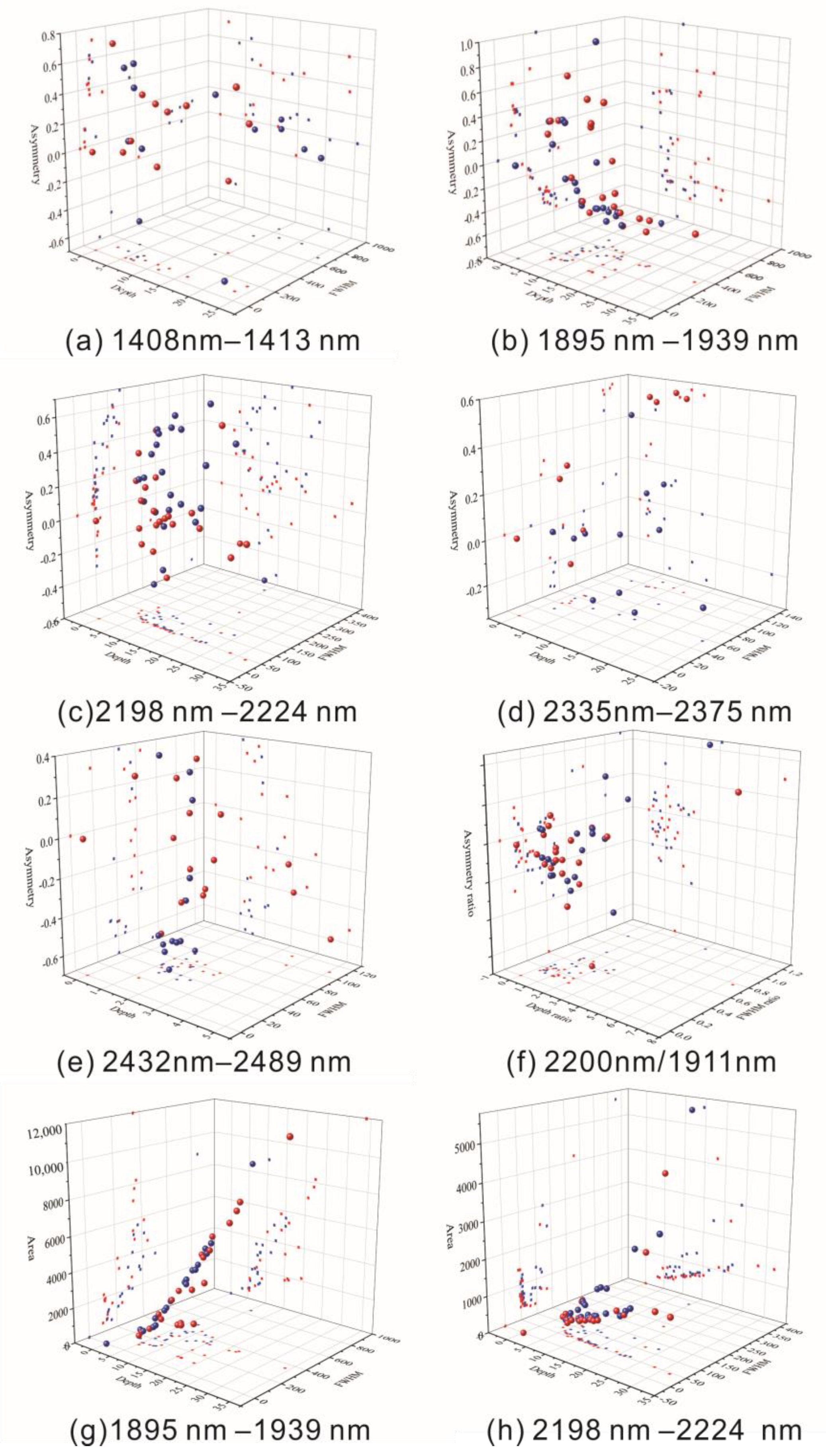
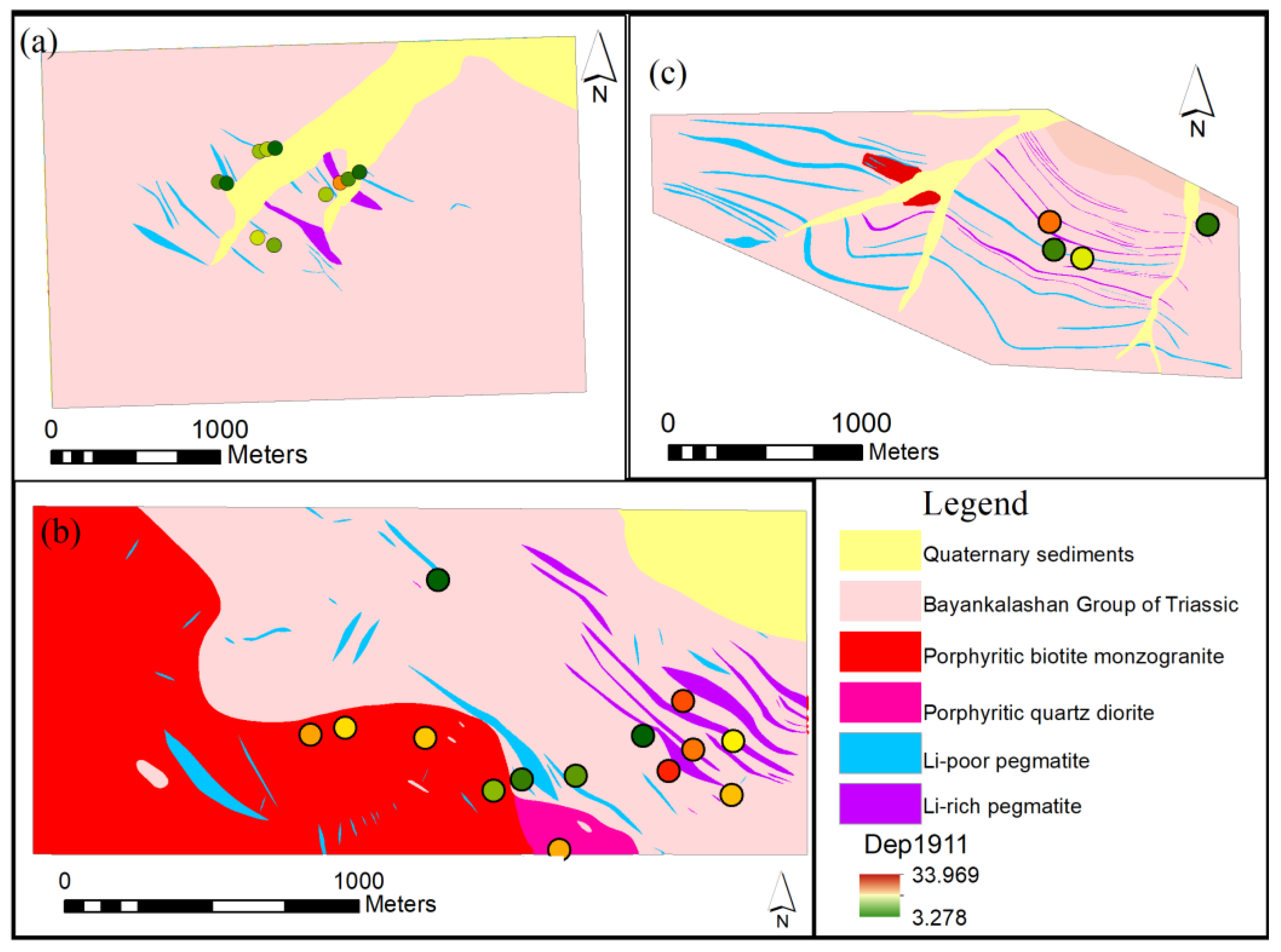
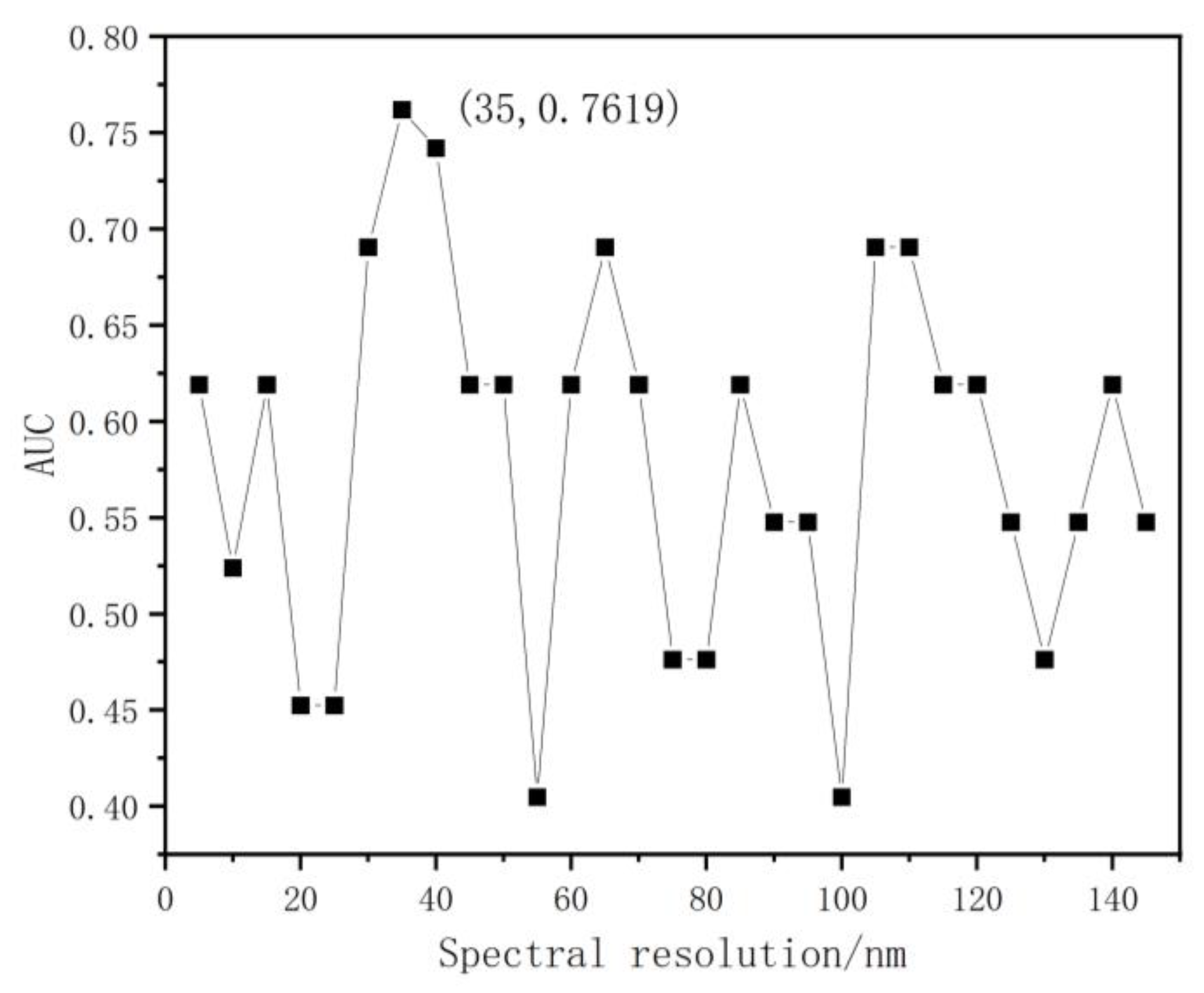



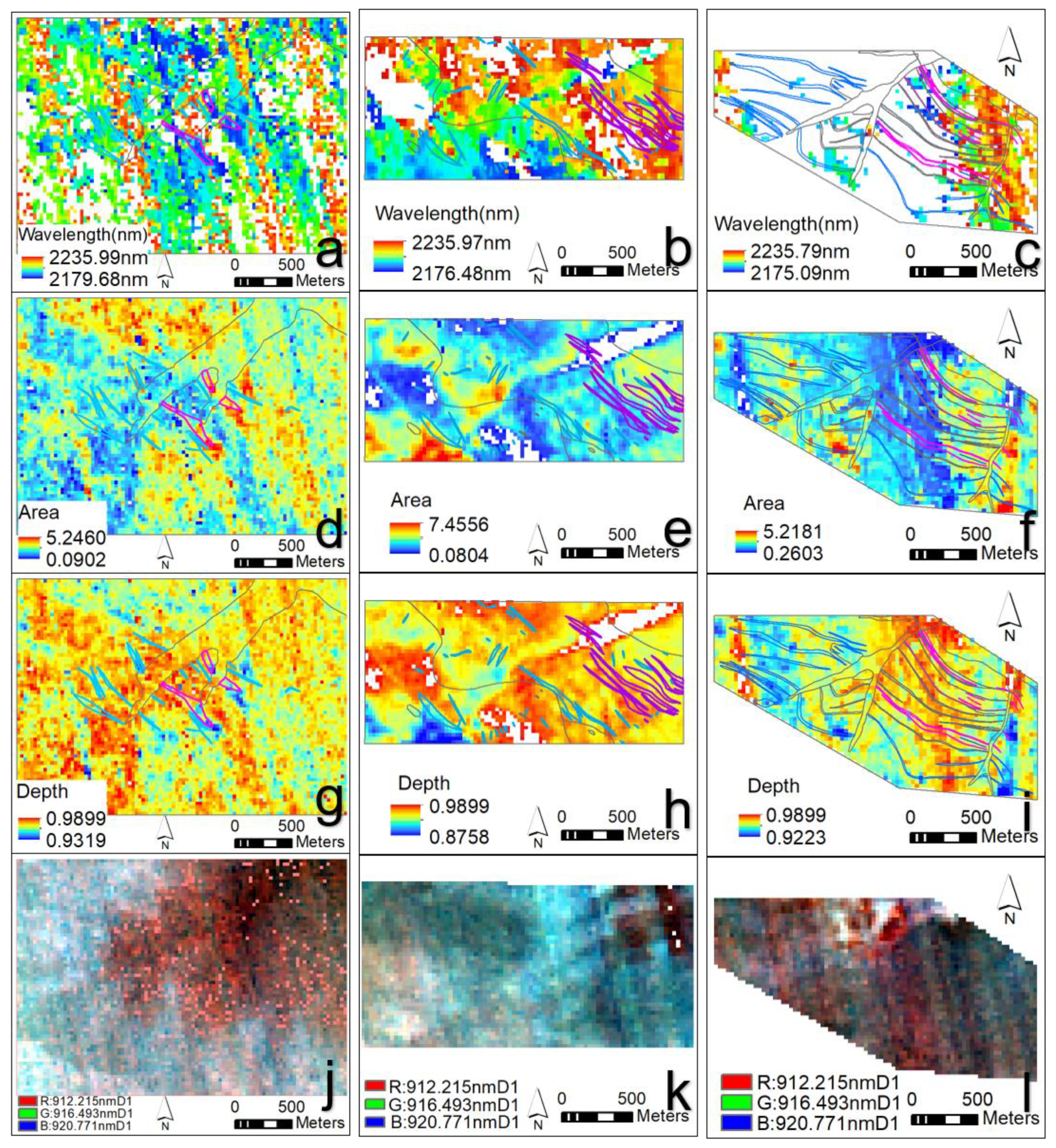


| Predicted Real | Validation Dataset | ||
|---|---|---|---|
| P | N | ||
| Predictive dataset | T | True Positive | False Positive |
| F | True Negative | False Negative | |
| Dataset | Pre-Processing | Parameter | ||||
|---|---|---|---|---|---|---|
| n_Estimator | Max_Depth | Min_Samples_Leaf | Min_Samples_Split | |||
| Full-range | Lars | Raw | 5 | 30 | 1 | 2 |
| CR | 5 | 40 | 1 | 4 | ||
| D1 | 25 | 15 | 1 | 4 | ||
| GA | Raw | 5 | 20 | 2 | 4 | |
| CR | 25 | 10 | 1 | 4 | ||
| D1 | 25 | 30 | 2 | 2 | ||
| Aug-Lars | Raw | 5 | 45 | 1 | 2 | |
| CR | 5 | 50 | 2 | 4 | ||
| D1 | 5 | 25 | 1 | 3 | ||
| Aug-GA | Raw | 10 | 15 | 1 | 2 | |
| CR | 10 | 20 | 2 | 3 | ||
| D1 | 10 | 10 | 1 | 2 | ||
| local features | 10 | 25 | 1 | 2 | ||
| F1-Score | Kappa | OA (%) | ||||||
|---|---|---|---|---|---|---|---|---|
| Q | TB | ρ | Li-ρ | Granite | Diorite | |||
| Akesayi | 0.959 | 0.989 | 0.464 | 0.771 | - | - | 0.907 | 98.045% |
| 509 | 0.967 | 0.951 | 0.576 | 0.602 | 0.981 | 0.929 | 0.910 | 94.522% |
| Longmengshan | 0.794 | 0.944 | 0.426 | 0.154 | 0.821 | - | 0.583 | 89.897% |
Disclaimer/Publisher’s Note: The statements, opinions and data contained in all publications are solely those of the individual author(s) and contributor(s) and not of MDPI and/or the editor(s). MDPI and/or the editor(s) disclaim responsibility for any injury to people or property resulting from any ideas, methods, instructions or products referred to in the content. |
© 2023 by the authors. Licensee MDPI, Basel, Switzerland. This article is an open access article distributed under the terms and conditions of the Creative Commons Attribution (CC BY) license (https://creativecommons.org/licenses/by/4.0/).
Share and Cite
Chen, L.; Zhang, N.; Zhao, T.; Zhang, H.; Chang, J.; Tao, J.; Chi, Y. Lithium-Bearing Pegmatite Identification, Based on Spectral Analysis and Machine Learning: A Case Study of the Dahongliutan Area, NW China. Remote Sens. 2023, 15, 493. https://doi.org/10.3390/rs15020493
Chen L, Zhang N, Zhao T, Zhang H, Chang J, Tao J, Chi Y. Lithium-Bearing Pegmatite Identification, Based on Spectral Analysis and Machine Learning: A Case Study of the Dahongliutan Area, NW China. Remote Sensing. 2023; 15(2):493. https://doi.org/10.3390/rs15020493
Chicago/Turabian StyleChen, Li, Nannan Zhang, Tongyang Zhao, Hao Zhang, Jinyu Chang, Jintao Tao, and Yujin Chi. 2023. "Lithium-Bearing Pegmatite Identification, Based on Spectral Analysis and Machine Learning: A Case Study of the Dahongliutan Area, NW China" Remote Sensing 15, no. 2: 493. https://doi.org/10.3390/rs15020493
APA StyleChen, L., Zhang, N., Zhao, T., Zhang, H., Chang, J., Tao, J., & Chi, Y. (2023). Lithium-Bearing Pegmatite Identification, Based on Spectral Analysis and Machine Learning: A Case Study of the Dahongliutan Area, NW China. Remote Sensing, 15(2), 493. https://doi.org/10.3390/rs15020493







